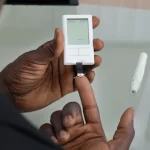
If you’ve been wondering “What is Diabetes?” and are looking for a simple explanation, you’ve come to the right place. Diabetes is a metabolic disorder that causes too much sugar in your blood. It’s not caused by too much sugar in your diet, but by how your body handles and regulates it. More than 34.2 million adults were estimated to have some form of diabetes in 2018, and it ranked seventh in the number of deaths worldwide.
When people have diabetes, their bodies fail to make or use insulin properly, causing their blood glucose levels to rise. Normally, glucose breaks down in the bloodstream to fuel the body’s cells. Without insulin, the glucose stays in the bloodstream instead of being used by cells. When this happens, blood glucose levels rise, and your body’s cells can’t use the glucose. This causes the blood glucose level to rise and lead to numerous problems.
Type 2 diabetes is the most common type of diabetes, accounting for about 90 percent of cases. One out of five people with diabetes don’t know they have it. Type 2 diabetes typically develops in middle age or later and is more common in blacks, Hispanics, and Asians. It is closely linked to excess weight. In fact, 89 percent of people with diabetes are overweight or obese. Luckily, there are some steps you can take to delay the onset of the disease.
One of the first steps in addressing type 2 diabetes is to know your body’s insulin needs. Without insulin, your body is unable to make enough insulin to properly utilize it. Insulin is the hormone that helps glucose enter your cells. Without insulin, glucose stays in the blood and causes damage to your body’s organs, blood vessels, nerves, and more. Luckily, there are many treatment options for type 2 diabetes, including insulin shots.
Despite the lack of a cure for type 2 diabetes, there are many ways to manage your disease. The best way to do that is to follow the care plan prescribed by your health care provider. If your blood sugar level fluctuates, let your provider know right away. By working together, you’ll be able to control your diabetes. This is a lifelong goal. If you’re ready to start coping with type 2 diabetes, then you’ve come to the right place.
Type 1 diabetes occurs when your body’s immune system attacks insulin-producing cells. This type of diabetes can strike at any age, but is usually diagnosed in childhood or early adulthood. People with type 1 diabetes are dependent on insulin injections every day to maintain their normal blood glucose levels. Fortunately, type 2 diabetes is usually manageable with healthy eating and regular exercise. Sometimes, insulin therapy is required. If you have this type of diabetes, you should consult your doctor or healthcare professional as soon as possible.
If you are pregnant, you should be tested for it. Pregnancy-induced diabetes can be fatal and can cause a baby to be born with defects or a stillbirth. When it affects the fetus, high blood glucose levels can lead to complications in pregnancy, including diabetic ketoacidosis, blindness, and nerve damage. In severe cases, diabetes can cause diabetic ketoacidosis, preeclampsia, and diabetes-related high blood pressure.



